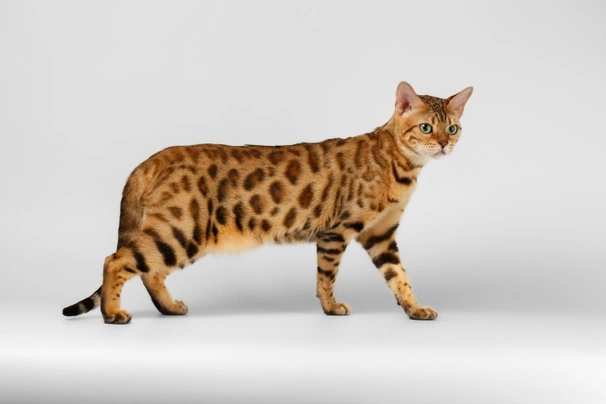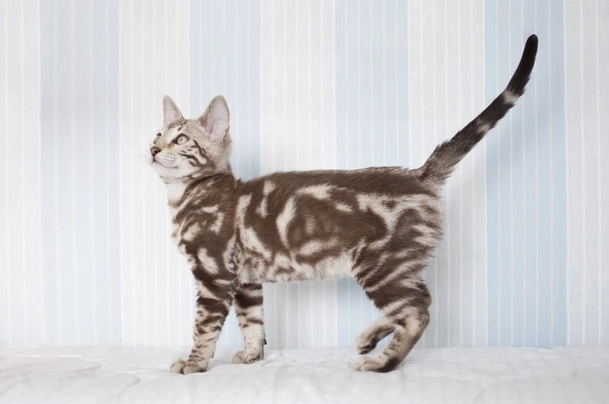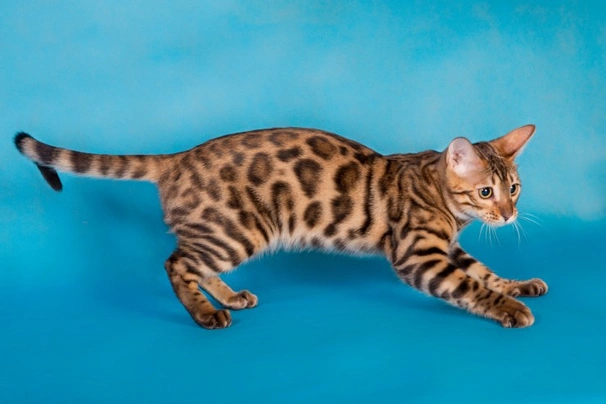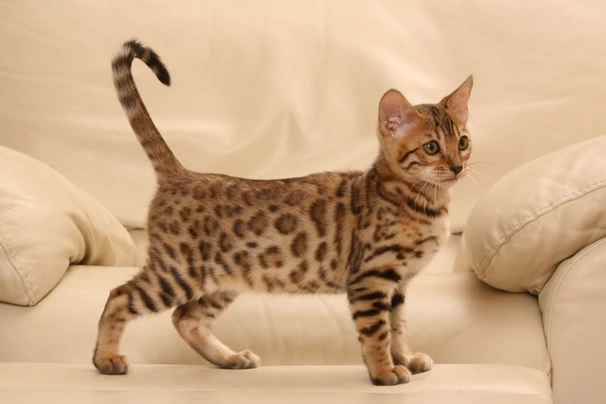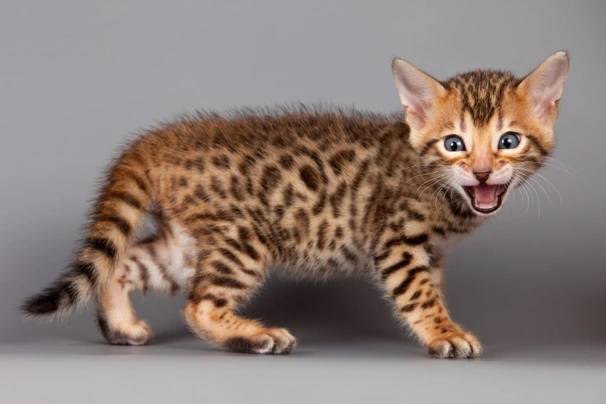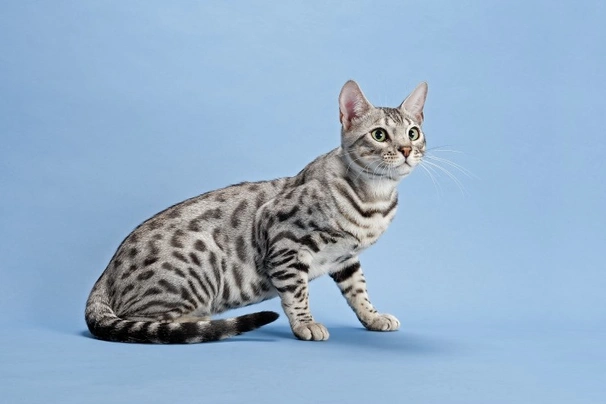Bengal
Introduction of the Bengal
The Bengal was first bred in the United States and is a relative newcomer to the cat scene. They are medium to large size cats that boast a lot of presence with their strong athletic bodies and sleek marbled or spotted coats. They were created by crossing between the Asian Leopard Cat with domestic breeds which includes the Egyptian Mau Ocicats and Abyssinians. They are known to have outgoing personalities which when paired to their wild good looks has seen the Bengal become a popular choice both as a companion and family pet not only in the UK but elsewhere in the world too.
History of the Bengal
The Bengal was only introduced to the UK very recently having been bred in America during the seventies. The breed was finally recognised by the GCCF back in 1997 but only awarded full Championship status a few years later in 2005. Bengals were first developed by crossing Asian Leopard Cats with domestic tabbies which produced first generation hybrid females (F1). Other breeds were then introduced into the mix which included the Burmese Egyptian Mau and Abyssinian with an end goal being to widen the breed's gene pool.
The breed's founder Jean S Mill wanted to create a cat that resembled a miniature leopard but which boasted a sweet affectionate nature. Bengals are the only successful mating between a wild cat and domestic cat with many breeders and international breed organisations having been against such a pairing. However through careful and selective breeding Jean Mill managed to create and develop a cat that did not boast having the "wild" traits seen in the Asian Leopard Cat and as such the breed has over the years enjoyed much success throughout the world.
The first three generations (F1 F2 and F3) are considered the "foundation" stock for all Bengals we see today. When it comes to fourth generation it's essential that breeders only mate Bengals to other Bengals which then means they can be considered as being a "pure breed".
Appearance of the Bengal
The Bengal boasts being a handsome eye catching medium to large breed not only because of their lovely marbled or spotted coats but also because of their elegant muscular and well balanced appearance. They always have an alert keen expression which when paired to their friendly affectionate natures makes them dependable companions and great family pets. Females tend to be that much smaller than their male counterparts but both carry their tails low much like a wild cat would.
They have broad wedge-shaped heads with nice rounded contours. Their heads are a little longer than they are wide with cats having lovely high cheek bones. A Bengal's head is small in relation to the rest of their body without it being too extreme. When seen in profile there's a slight curve from a cat's forehead to the bridge of their noses which are broad and large. Muzzles are full and broad with cats having a strong rounded chin and very pronounced whisker pads which adds to their overall "wild" appearance. They have thick muscular necks with mature males having quite obvious jowls.
Ears are small to medium in size being wider at the base with rounded tips. They are set well apart on a cat's head and boast having a small amount of furnishing on them. They have round to oval shaped large eyes that are set with a slight slant towards the base of a cat's ears.
Bengals have long muscular and sleek bodies with well-rounded and nicely developed hindquarters which are a little higher than their shoulders. They have medium length strong and muscular legs with their back ones being that bit longer than their front legs. Paws are nice and round being large in size. Tails are moderately long and thick with a rounded tip to them.
When it comes to their coat the Bengal boasts having a short to medium length coat that's extremely dense soft and luxurious to the touch. Kittens tend to have slightly longer coats than mature adult cats.
Spotted Bengals
Spotted Bengals have a distinct letter "M" on their foreheads found above distinctly outlined eyes. They have a complex scarab marking on each side of their heads from with broken spots or streaks running down their necks and over their shoulders before they turn into "rosettes".
The rosettes are made up of a part circle of spots found around a lighter coloured centre. Cats have very distinct chin straps broken or unbroken necklets and mascara markings together with horizontal streaks or spots on their shoulders. Their under bellies can be spotted and their legs can also have broken horizontal spots and/or lines on them. A Bengal's tail has rings spots and/or streaks along the whole length with a dark solid colour at the tip.
Marbled Bengals
A cat's spectacles extend to vertical streaks outlined by the letter "M" on their forehead. Cats have broken streaks that run on either side of a complex scarab marking and over their heads right down to their necks and then onto their shoulders. They have well defined chin straps strong mascara markings and very distinct unbroken or broken necklets together with undefined horizontal streaks on their shoulders. The patterns in their coats are well defined but not symmetrical which is how cats get their "marbled" look.
A cat's stomach is spotted with the exception being in Blue-Eyed Snow kittens. Cats can also have spots or broken horizontal lines on their legs and tails can be ringed spotted and/or marbled its whole length but always with a solid dark tip.
The different variations in a Bengal's coat colour are as follows:
- Brown (Black) Spotted
- Brown (Black) Marbled
- Blue-Eyed Snow Spotted
- Blue-Eyed Snow Marbled
- AOC-Eyed Snow Spotted
- AOC-Eyed Snow Marbled
- Black Silver Spotted
- Black Silver Marbled
- Blue-Eyed Silver Snow Spotted
- Blue-Eyed Silver Snow Marbled
- AOC-Eyed Silver Snow Spotted
- AOC-Eyed Silver Snow Spotted
Temperament of the Bengal
The Bengal has fast become known as being a wonderful choice both as a family pet and companion. They form a strong bond with one person in a household although affectionate and friendly with everyone in a home. They are also known to be extremely intelligent and remain very playful right into their golden years. Unlike many other of their feline counterparts the Bengal loves being in and around water which includes playing with a running tap or watching the water in a toilet when it's flushed. Many Bengals will happily jump in a pond or in the shower with their owners because of their love of water.
They thrive on human company and don't like to be left on their own for long periods of time. They are definitely not lap cats preferring to be kept busy but when tired a Bengal is always happy to curl up beside their owner on a sofa. With this said there's nothing a Bengal enjoys more than being in the great outdoors because they boast a strong hunting instinct a trait passed down to them from their wild heritage. However as with any other breed it’s never a good idea to let them explore outdoors if you live in town or near a road.
As such many owners decide to keep their Bengals are indoor pets and they do adapt well to not being allowed to roam around in the great outdoors. However they are high energy cats and as such they need to be kept busy to be truly happy which means investing in lots of good quality interactive toys. They also like to be up "high" which means building them indoor platforms so they can look down on the world from their vantage point.
Intelligence / Trainability of the Bengal
The Bengal is among one of the most intelligent cats on the planet. They are quick to learn new things and they adore playing interactive games which includes activities like "fetch". Because they are so smart Bengals need to be kept busy to prevent boredom from setting in. Cats kept as indoor pets need to be given lots of interactive toys to play with and they also need to have access to high platforms so they can climb up and look down on the world below something that Bengals love doing. They don’t like to be left on their own and do a lot better in households where they are other cats or a dog. They are a great choice for families where at least one person stays at home when everyone else is out of the house.
Children and other
Bengals make wonderful family pets because they are so social by nature. They enjoy the company of children and will spend hours playing interactive games with them. However younger children need to be taught how to behave around cats to prevent any mishaps and any interaction should always be well supervised by an adult.
They are also known to be good around dogs especially if they have grown up together in a household. They are known to be quite territorial which means introducing another cat into a household can prove challenging. With this said when two cats have grown up together they become best friends although they may have the occasional spat when establishing a pecking order. Care should be taken when a Bengal is around any smaller animals and pets which they may well see as "fair game" bearing in mind they boast having a strong hunting instinct. As such any contact is probably best avoided just in case.
Health of the Bengal
The average life expectancy of a Bengal is between 12 and 16 years when properly cared for and fed an appropriate good quality diet to suit their ages.
Bengals are known to be a healthy breed however there are a few health disorders which are occasionally seen in Bengals worth knowing about when thinking of sharing a home with one of these intelligent extraordinary and talkative cats. The health issues that have been occasionally reported in the breed are as follows:
- Flat Chested Kitten Syndrome (FCKS)
- Patellar luxation
- Hip dysplasia
- Pyruvate kinase deficiency – Breeders should have stud cats DNA tested
- Progressive retinal atrophy (PRA) – Breeders should have stud cats tested
- Hypertrophic Cardiomyopathy
Caring for the Bengal
Bengals need to be groomed on a regular basis to make sure their coats and skin are kept in top condition. On top of this cats need to be fed good quality food that meets all their nutritional needs throughout their lives. They also need to be given lots to do because being so intelligent a Bengal would quickly get bored if left on their own for long periods of time especially when they are kept as indoor cats.
Grooming of the Bengal
Bengals boast having short close lying luxurious coats and as such they are low maintenance on the grooming front. A weekly brush and wipe over with a chamois leather is all it takes to keep their coats in good condition with a nice sheen on it. Like other breeds they tend to shed the most in the Spring and then again in the Autumn when more frequent brushing is usually necessary to keep on top of things.
It's also important to check a cat's ears on a regular basis and to clean them when necessary. If too much wax builds up it can lead to a painful infection which can be hard to clear up. In short prevention is often easier than cure with ear infections. Cats often suffer from ear mites which can be a real problem which is another reason why it's so important to check their ears on a regular basis.
Exercise of the Bengal
Bengals boast having a lot of energy and therefore they need to be kept busy to be truly happy. They are definitely not lap cats although when tired a Bengal would happily curl up next to an owner on a sofa. When kept as indoor pets Bengals need to be given lots of things to do and places to hide when they want to bearing in mind that they love nothing more than to be up high.
Many breeders recommend that owners only let their Bengals out into secure enclosed gardens they cannot get out of especially if they live in town or near busy main roads. Because Bengals are expensive cats they could also be targeted by thieves which is another thing that owners need to bear in mind when sharing their homes with one of these lovely looking felines.
Feeding of the Bengal
If you get a Bengal kitten from a breeder they would give you a feeding schedule and it's important to stick to the same routine feeding the same kitten food to avoid any tummy upsets. You can change a kitten's diet but this needs to be done very gradually always making sure they don't develop any digestive upsets and if they do it's best to put them back on their original diet and to discuss things with the vet before attempting to change it again.
Older cats are not known to be fussy eaters but this does not mean they can be given a lower quality diet. It's best to feed a mature cat several times a day making sure it's good quality food that meets all their nutritional requirements which is especially important as cats get older. It's also essential to keep an eye on a cat's weight because if they start to put on too much it can have a serious impact on their overall health and wellbeing. Like all other breeds Bengals need to have free access to fresh clean water at all times.
Bengal price
If you are looking to buy a Bengal you would need to pay anything from £400 to over £1500 for a well-bred kitten. The cost of insuring a male 3-year-old Bengal in northern England would be £15.53 a month for basic cover but for a lifetime policy this would set you back £27.04 a month (quote as of Sept 2016). When insurance companies calculate a pet's premium they factor in several things which includes where you live in the UK a cat's age and whether they have been neutered or spayed among other things.
When it comes to food costs you need to buy the best quality food whether wet or dry making sure it suits the different stages of a cat’s life. This would set you back between £15 - £20 a month. On top of this you need to factor in veterinary costs if you want to share your home with a Bengal and this includes their initial vaccinations their annual boosters the cost of neutering or spaying a cat when the time is right and their yearly health checks all of which quickly adds up to over £600 a year.
As a rough guide the average cost to keep and care for a Bengal would be between £30 to £50 a month depending on the level of insurance cover you opt to buy for your cat but this does not include the initial cost of buying a well-bred kitten.

Kittens
£200
BENGAL❌KITTENS
£450
